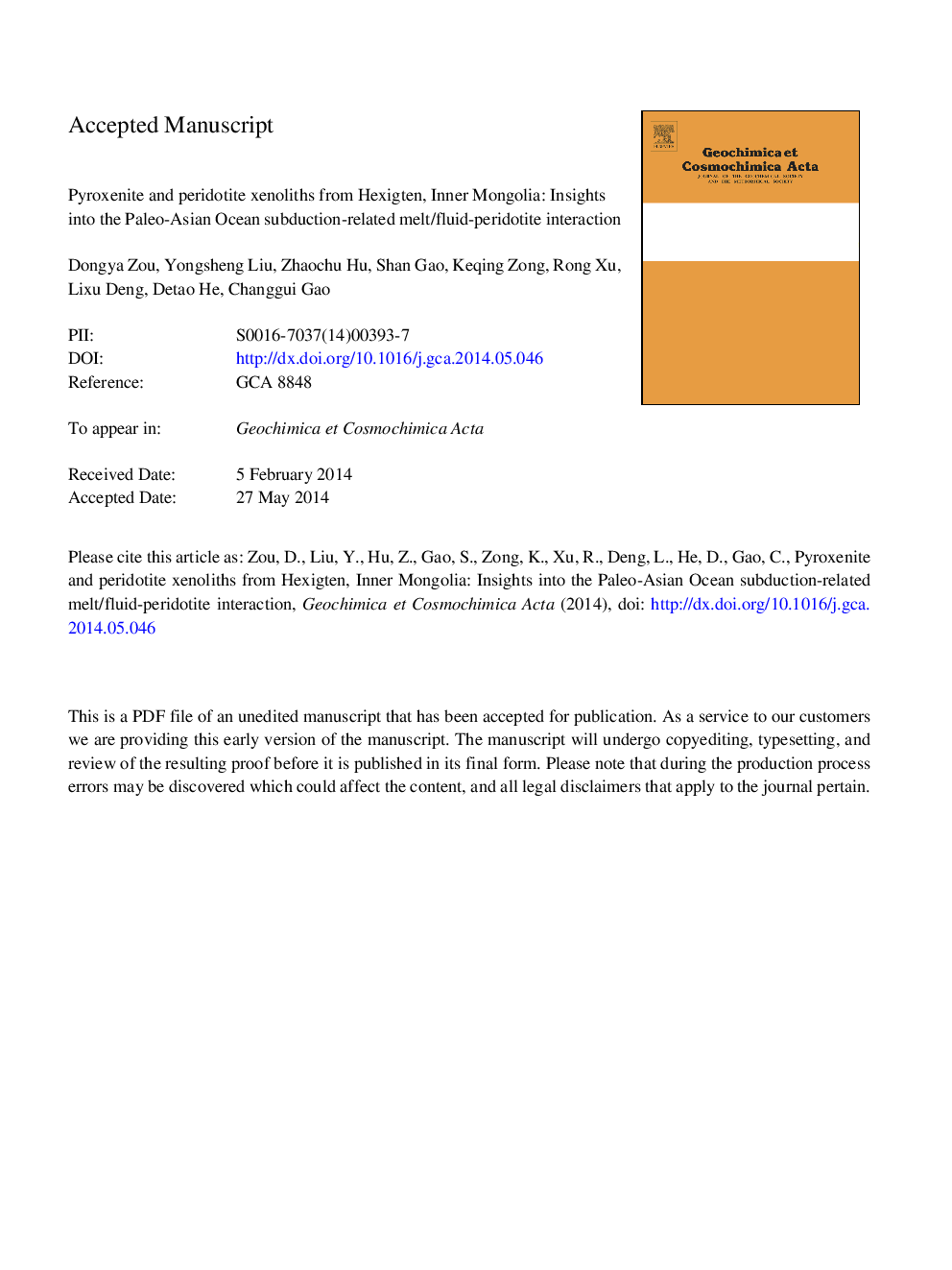| کد مقاله | کد نشریه | سال انتشار | مقاله انگلیسی | نسخه تمام متن |
|---|---|---|---|---|
| 6438388 | 1638017 | 2014 | 57 صفحه PDF | دانلود رایگان |
عنوان انگلیسی مقاله ISI
Pyroxenite and peridotite xenoliths from Hexigten, Inner Mongolia: Insights into the Paleo-Asian Ocean subduction-related melt/fluid-peridotite interaction
دانلود مقاله + سفارش ترجمه
دانلود مقاله ISI انگلیسی
رایگان برای ایرانیان
موضوعات مرتبط
مهندسی و علوم پایه
علوم زمین و سیارات
ژئوشیمی و پترولوژی
پیش نمایش صفحه اول مقاله

چکیده انگلیسی
The in situ major, trace-element and Sr-isotopic compositions of the peridotite and pyroxenite xenoliths from the Hexigten region in the Xing-Meng orogenic belt (XMOB) were examined to evaluate the influences and contributions of the Paleo-Asian Oceanic slab subduction on the lithospheric mantle transformation. Pyroxenes in the Type 1 pyroxenite exhibit low and variable Mg# (67-85) and relatively high 87Sr/86Sr ratios (0.7036-0.7053), indicating that they were formed by assimilation and fractional crystallization processes during a basaltic underplating event. The peridotite and Type 2 pyroxenite xenoliths sampled the lithospheric mantle and recorded subduction-related metasomatism. The mineral chemistries of the Type 1 peridotite suggest that the lithospheric mantle beneath this area suffered 1-15% melt extraction. Clinopyroxene (Cpx) in some Type 1 peridotites are characterized by high (La/Yb)N coupled with marked depletions in high field strength elements (HFSE) (Nb, Ta, Zr, Hf and Ti) and negative correlations between the low Ti/Eu (Nb/La) and 87Sr/86Sr ratios (0.7037-0.7055), suggesting metasomatism by subduction-related CO2-rich fluids. Olivine (Ol) and orthopyroxene (Opx) in the Type 2 peridotite are characterized by a relatively low Mg# but high Ni contents. In addition to the normal incompatible element-depleted Opx, Opx with enrichments in Rb, Ba, Th, U, Nb, Ta and LREE were observed, as well. The Mg# of incompatible element-depleted Opx exhibits weak zonations (i.e., decreasing from the cores to the rims). Cpx and Opx of the Type 2 pyroxenite exhibit similarly high Mg# and Ni contents. Rb, Ba, Th, U, Nb, Ta and LREE contents and 87Sr/86Sr ratios of the Cpx increase from the cores to the rims. Moreover, Opx in the Type 2 peridotite and Cpx in the Type 2 pyroxenite exhibit increased Nb/Ta ratios and Ni contents relative to those in the Type 1 peridotites. These observations collectively suggest a rutile-bearing eclogite-derived silicic melt-peridotite reaction as the origin for the Type 2 peridotite and pyroxenite. Considering the geological setting, it is suggested that the melt/fluid-peridotite interactions were caused by the Paleo-Asian Ocean subduction, which could have contributed significantly to the transformation of the lithospheric mantle beneath the northern margin of the NCC, as well.
ناشر
Database: Elsevier - ScienceDirect (ساینس دایرکت)
Journal: Geochimica et Cosmochimica Acta - Volume 140, 1 September 2014, Pages 435-454
Journal: Geochimica et Cosmochimica Acta - Volume 140, 1 September 2014, Pages 435-454
نویسندگان
Dongya Zou, Yongsheng Liu, Zhaochu Hu, Shan Gao, Keqing Zong, Rong Xu, Lixu Deng, Detao He, Changgui Gao,